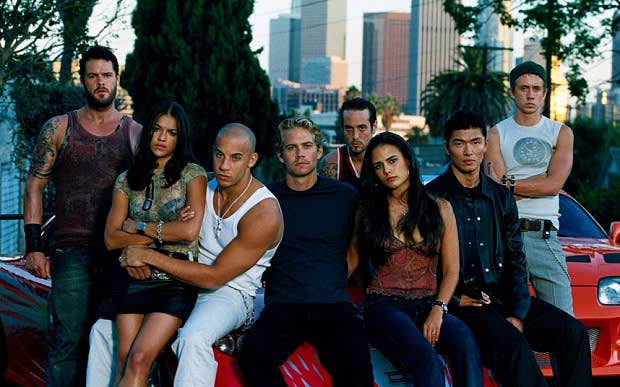
In May of 1998, Vibe magazine published a story called "Racer X," about Rafael Estevez, a man with a souped up 1992 Honda Civic who was dominating the underground street racing circuit in New York City. A trend that began in the early '90s in Southern California, street racing had been feverishly adopted by an eclectic mix of minorities in New York, especially in the boroughs of Queens and Brooklyn. Kenneth Li, writing for Vibe, unearthed an entire culture—the way these people would race by night and work tirelessly on their cars and hang out at auto shops by day. They were a different kind of outcasts, a convergence of ethnicities, rebellion, and hip-hop attitude that was arguably two decades ahead of its time.
Director Rob Cohen saw the potential in bringing this underground world to the big screen. After reading "Racer X," he started doing more research, with the aims of developing the story for film. "I went to an aftermarket parts convention and learned so much," Cohen tells me. "I remember it was like the scene in All the President's Men—we were scribbling things on our hands and on our t-shirts and on pieces of paper. This was in a fact a separate world. [And] I noticed there were these mixed up niches—there were the Vietnamese kids, and there were the whites, and there were the blacks, and there the Hispanics, the Latinos. It just seemed like, wow, here was the United Nations of Rice Rockets."
The decision was made to focus on a similarly mixed group of streetracers, and to take the action back to the underground culture's birthplace, East Los Angeles. Cohen also paid for the rights of a 1955 movie so he could use its title—The Fast and the Furious—for his movie.

Vin Diesel's character Dominic Toretto—"a lion in a very small cage," as Cohen describes him—was composed first; the rest of the group—Brian, Letty, Mia, Vince, Jesse, and Leon—came later. But the group dynamic you see in the finished version of The Fast and the Furious, in which Paul Walker's Brian O'Connor is an undercover cop who assimilates with Toretto's streetracing gang, wasn't yet established. "The original story, they were all anti-heroes," Furious screenwriter and original story creator Gary Scott Thompson says.
"I went into Universal and told them my take: Romeo & Juliet in cars. I told them how I thought it would go, these competing [groups], with Brian and Mia meeting for this big race war," Thompson explains. "I did my drafts, and the studio called and said, 'We love this, it's great. We're going to do this movie.' Then Columbine happened."
On April 20, 1999, two high school students executed a highly planned attack at Columbine High School in Colorado, killing 12 students and one teacher, injuring 24 others before committing suicide. The massacre, the deadliest school shooting in the U.S. at the time, rattled the nation. In the wake of nationwide mourning, debate was not only sparked surrounding gun control, but also around the country's depiction of gun violence in pop culture. Movies like Natural Born Killers and video games like DOOM were pointed out as influencing factors for the teens who carried out the shooting.
In the midst of this conversation, a movie about a group of armed anti-heroes who hijacked trucks and fought each other was more or less poisonous to a studio like Universal. "'We're not doing it. We can't, because Columbine,'" Thompson says the studio told him.
Forced to pivot or abandon the project altogether, a light bulb went off for the screenwriter. "I realized, there were no authority figures. We can make Brian a cop. We sort of do what they did in Point Break, and he goes undercover in this world." With an undercover cop as a protagonist, The Fast and the Furious could have a moral center, someone inherently good to offset any feelings of glorified violence and crime. The movie could be less about a motley group of anti-heroes, and more about the complex relationship between a compromised, but morally dignified cop and his troubled, but ideally good mark. "I called the president of the studio back and he said, 'Okay man, give it a shot,'" says Thompson. The Fast and the Furious we know was born: the main conflict between Brian O'Connor and Dominic Toretto fell in place, with Brian infiltrating this streetracing group with a criminal bent, only to develop real respect and feelings for them. The Romeo & Juliet aims were even slightly preserved in the love story between Brian and Mia, Toretto's sister.
"[The president] called me one day and said, 'Gary, we're making the movie, this is going to get made,'" Thompson says. Everything moved quickly after that: the movie was produced in less than two years, premiering as part of Universal's summer slate on June 22, 2001—15 years ago to the day tomorrow.
It's endlessly interesting to think of how drastically different The Fast and the Furious would have been had its development not been temporarily derailed by the tragedy of Columbine. Would the movie, which pre-dated anti-hero classics like Training Day and The Dark Knight, be considered influential for unapologetically focusing on bad guys? Would people point to it for kicking off the 21st century's obsession with anti-heroes?
Furthermore, what the movie did become post-Columbine still reverberates, as Universal pumps out sequel after sequel. In the six movies that have been made since the original Furious, Dom Toretto often remarks that "family" is the central point of this story, but distilled even further, the point is the friendship between him and Walker's Brian. What makes that friendship so strong, and so compelling, is how it started, namely, how two guys from completely different, opposing places bonded together. The flip Brian makes at the end of The Fast and the Furious—saving Dom from certain arrest by giving him his car keys—is the emotional apex of the movie, a moment that informs the rest of the series. It's hard to think that a Furious in which both Dom and Brian are badasses on the run would carry the same weight as the final result the world eventually saw.
The gang's back-and-forth relationship with authority has also been a driving force in the Furious sequels' storylines. It's part of the plot of every sequel, from 2 Fast 2 Furious to Furious 7. Probably most importantly, it's the crux of the story in Fast Five, the movie that undoubtedly reshaped the Fast saga and turned it into the phenomenon it is today. Would Agent Luke Hobbs, played by Dwayne "The Rock" Johnson in a franchise-energizing turn, even exist without the original pretenses established in Thompson's post-Columbine script?
An even better question: would a fifth Fast and Furious movie even exist if the first one was all about anti-heroes? No one can say for sure, but in some twisted way, the Columbine shooting had a role in the birth of the most successful, most iconic movie saga of the 21st century.

